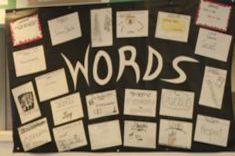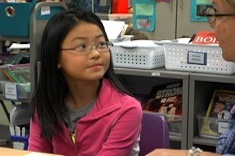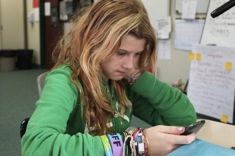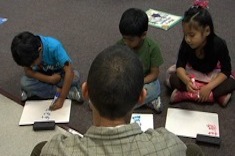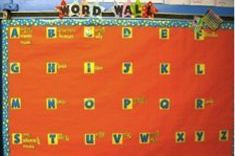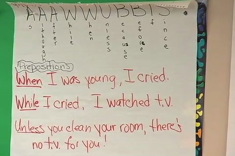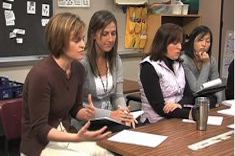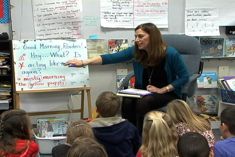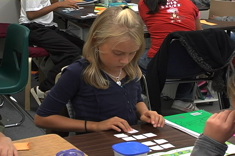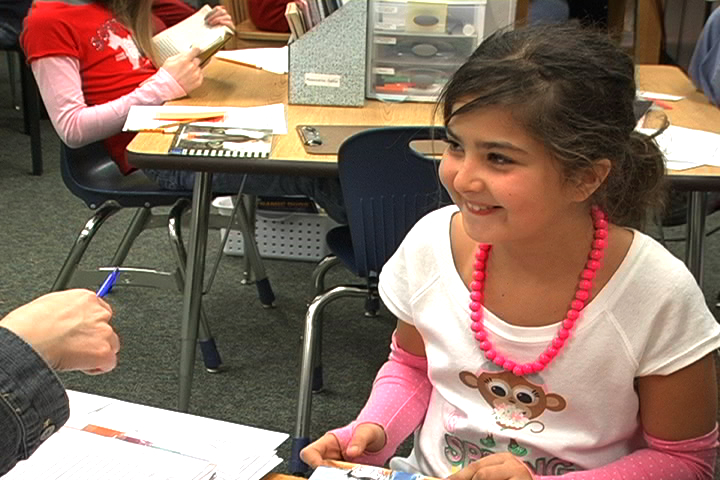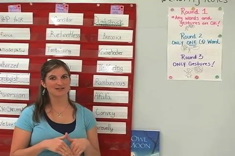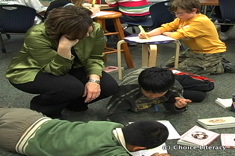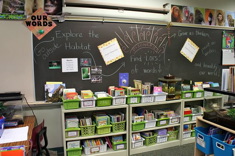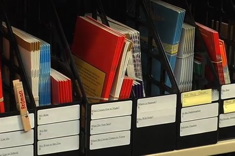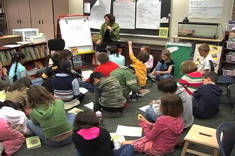Word Study and Vocabulary
Here is where you will find resources for teaching students about spelling, word features, vocabulary, and grammar.
Latest Content
Grouping Struggling Students for Word Study: A Case Study
Shari Frost considers the “go-to” instructional strategy for struggling readers, word study, and explores how to make it work well in a case study of a third-grade group.
Cooking Up Interest in Words with Fifth Graders
Maria Caplin continues her series on sparking vocabulary learning, this time highlighting fun activities.
Weaving Word Study into Writing Workshop in 5th Grade
Maria Caplin describes how she integrates word study with intermediate students in writing workshops.
Highlighting Language in a Writing Conference
Karen Terlecky confers with fifth grader Nora about her evocative language during writing workshop.
Integrating Vocabulary and Retelling Strategies into Read-Aloud
Stella Villalba scaffolds the language development of her first- and second-grade English language learners during read-aloud by highlighting vocabulary and providing a tool to assist with a partner retelling activity.
Vocabulary and iPhones: A Four-Step Process for Independent Student Word Learning
Bryce Bennett develops a four-step process to help high school students use their smartphones to master difficult vocabulary while reading.
Student-Selected Vocabulary in Middle School
Katie Doherty shares many ways to make vocabulary learning fun in middle school, beginning with students working together to select words to study each week.
Using Wipe-Off Boards with Young English Language Learners
Max Brand describes why wipe-off boards are such a valuable tool for work with young English language learners in small groups. The article includes a video demonstration.
Book Matchmaker: Nonfiction to Read Cover to Cover
With the Common Core emphasis on nonfiction, teachers are striving to integrate more nonfiction texts throughout their literacy workshops. Franki Sibberson shares her favorite nonfiction texts that can be read cover to cover.
Finding a Fit (The Power of Conventions Series)
Heather Rader works with a teaching team as they integrate conventions instruction into their writing workshop.
Shifting from Spelling to Word Study in 5th Grade
Maria Caplin explains how she made the shift from spelling to word study in the intermediate grades.
What’s Up with Those Word Walls?
Shari Frost visits classrooms early in the year and finds many have completely full word walls. In this essay, she shares research as well as practical reasons why it’s best to build the walls over time with students.
Getting Started with Sentence Observations
Karen Terlecky details the assessments and preparation that goes into the design of her sentence observation program.
Vocabulary, Comprehension, and the Common Core: A Conversation with Doug Fisher (PODCAST)
In this podcast, Doug Fisher discusses how vocabulary fits into the Common Core State Standards.
Literacy Team Meeting: Focus on Word Work Part 2
In the second part of the literacy team meeting, teachers on the team move from the focus on sharing, to the important phase of where to go next as a team and as a school. Because the crucial work of the team is the work done between meetings, this is a critical discussion.
Noticing Words in Second Grade
In this brief video from Linda Karamatic’s 2nd grade classroom, students share words they are noticing, and Linda talks about making revisions to the wall displays of words in the classroom. She also mentions the word “wretched” which the class discussed the previous day, and how the word might be used naturally in conversations.
6th Grade Word Sort
In this six-minute video, Pam Pogson leads an open word sort with her 6th grade students.
Listen In: Spelling Aids in the Writing Workshop
Many commercial aids are available to assist young writers. The challenge is choosing carefully, and integrating them into workshops in a way that doesn’t inhibit student fluency and risk-taking. In this video, Heather Rader confers with a second grader, demonstrating how to use a spelling log for high-frequency words.
Common Core Conversations: Vocabulary
Amanda Adrian and Heather Rader explore connections between the Common Core and vocabulary instruction.
Linking Morning Message, Poetry, and Word Learning
Second-grade teacher Linda Karamatic has been starting her morning with a message for years. The morning message is just one part of her daily opening that reinforces community.
First Grade Guided Writing Group: Targeting Common Spelling Needs
In this video of a 1st grade guided writing group, Katie DiCesare works with children to address common issues with spelling and conventions. By grouping the students together, she is able to use her time well in addressing common needs among students.
Using Picture Books to Spice Up Vocabulary Instruction (BOOKLIST)
Picture books are a terrific tool for vocabulary instruction – students have so much fun reading them they are hardly aware of all the new words they are picking up. Franki Sibberson shares her top picks for spicing up vocabulary instruction in this booklist.
Vocabrity: Fun with Words for Middle School Students
Are your students getting bored with vocabulary routines? Katie Doherty invents a quick and fun game, Vocabrity, to help her middle school students learn words.
Ecstatic: When Words Shape Thinking
Carol Wilcox prepares her struggling intermediate readers for state exams, and finally experiences a breakthrough in linking vocabulary learning to authentic reading.
Mentor Texts for Word Choice (BOOKLIST)
Choosing words in writing is a key to effectively communicating ideas. Franki Sibberson finds that the best way to introduce and extend conversations about words is through the use of picture books.
Living Words: Integrating Word Study, Technology, and Content Literacy (Part 1)
Living Words is a quick routine from Andrea Smith that helps students see the power of rich vocabulary for describing the natural world around them.
Word Storms: Integrating Nonfiction, Word Study, and Technology
Word Storms help students see the power of rich vocabulary for describing the natural world around them. While Andrea Smith is working with 4th graders, the activities can be adapted for older or younger students.
Free Rice: Tools for Web-Based Vocabulary Learning
Mary Lee Hahn shares how she uses Free Rice in her classroom, as well as other online vocabulary learning tools.
Books for Phonics Instruction – Accomplishing More Than Just Sounding Out Words
Shari Frost finds herself appalled at some of the "books" children are reading in the name of phonics instruction, so she sets out to create a booklist of high quality children's literature that does more than just help children sound out words.
Reflecting on the First Six Weeks of Word Study
Franki Sibberson explains how she rethought word study during the first six weeks of school, giving manypractical examples of activities and routines with her intermediate students.
Browse Content By
Type
Category
- Assessment Tools
- Big Fresh Archives
- Booklists
- Choice Numeracy
- Classroom Design
- Common Core
- Community Building
- Conferring
- Content Literacy
- Digital Literacy
- English Language Learners
- Equity
- Family Relations
- Free Samples
- Guiding Groups
- Leadership
- Literacy Coaches
- Mentor Texts
- Minilessons
- New Teacher Mentors
- Podcasts
- Poetry
- Quote Collections
- Reading Strategies
- Self Care
- Struggling and Striving Learners
- Talking and Listening
- Teacher Study Groups
- Teaching Reading
- Teaching Writing
- Word Study and Vocabulary
Author
- Melissa Quimby
- Nawal Qarooni
- Gwen Blumberg
- Julie Cox
- The Lead Learners
- Hannah Tills
- Josie Stewart
- Ruth Metcalfe
- Mallory Messenger
- Becca Burk
- Jodie Bailey
- Vivian Chen
- Mary Brower
- Tiffany Abbott Fuller
- Stephanie Affinito
- Ruth Ayres
- Leigh Anne Eck
- Heather Fisher
- Shari Frost
- Julie Johnson
- Suzy Kaback
- Gigi McAllister
- Shirl McPhillips
- Melanie Meehan
- Cathy Mere
- Debbie Miller
- Tara Barnett and Kate Mills
- Tammy Mulligan
- Dana Murphy
- Bitsy Parks
- David Pittman
- Brenda Power
- Heather Rader
- Matt Renwick
- Mandy Robek
- Christy Rush-Levine
- Gretchen Schroeder
- Jen Schwanke
- Brian Sepe
- Katherine Sokolowski
- Stella Villalba
- Jennifer Vincent
Grade Level
Choice Literacy Membership
Articles
Get full access to all Choice Literacy article content
Videos
Get full access to all Choice Literacy video content
Courses
Access Choice Literacy course curriculum and training

